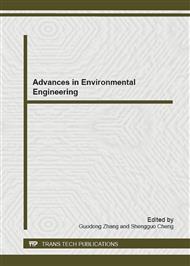[1]
M. F. Dignac, P. Ginestet, D. Ryback, A. Bruchet, V. Urbain, and P. Scribe, "Fate of wastewater organic pollution during activated sludge treatment: nature of residual organic matter", Water Research, Vol.34(17) (2000) ,pp.4185-4194.
DOI: 10.1016/s0043-1354(00)00195-0
Google Scholar
[2]
H. K. Shon, S. Vigneswaran, and S. A. Snyder, "Effluent Organic Matter (EfOM) in Wastewater: Constituents, Effects, and Treatment", Critical Reviews in Environmental Science and Technology, Vol.36 (2006),pp.327-374.
DOI: 10.1080/10643380600580011
Google Scholar
[3]
D. J. Barker, G. A. Mannucchi, S. M. L. Salvi, and D.C. Stuckey, "Characterisation of soluble residual chemical oxygen demand (COD) in anaerobic wastewater treatment effluents", Water Research,Vol.33(11) (1999) ,pp.2499-2510.
DOI: 10.1016/s0043-1354(98)00489-8
Google Scholar
[4]
S. F. Aquino, A. Y. Hu, A. Akram, and D. C. Stuckey, "Characterization of dissolved compounds in submerged anaerobic membrane bioreactors (SAMBRs)", Journal of Chemical Technology and Biotechnology, Vol.81(2006) ,pp.1894-1904.
DOI: 10.1002/jctb.1622
Google Scholar
[5]
S. F. Aqunio, and D. C. Stuckey,"Soluble microbial products formation in anaerobic chemostats in the presence of toxic compounds", Water Research, Vol.38(2004) ,pp.255-266.
DOI: 10.1016/j.watres.2003.09.031
Google Scholar
[6]
S. Rosenberger, C. Laabs, B. Lesjean, R. Gnirss, G. Amy, M. Jekel, and J.C. Schrotter, "Impact of colloidal and soluble organic material on membrane performance in membrane bioreactors for municipal wastewater treatment", Water Research, Vol.40(4) (2006) ,pp.710-720.
DOI: 10.1016/j.watres.2005.11.028
Google Scholar
[7]
A.T. Chow, S. Gao, and R. A. Dahlgren,Physical and chemical fractionation of dissolved organic matter and trihalomethaneprecursors: a review", Journal of Water Supply: Research and Technology-AQUA, Vol.54( 8) (2005) ,pp.475-507.
DOI: 10.2166/aqua.2005.0044
Google Scholar
[8]
J. Świetlik, A. Dąbrowska, U. Raczyk-Stanisławiak, and J. Nawrocki, "Reactivity of natural organic matter fractions with chlorine dioxide and ozone", Water Research, Vol.38 (2004) ,pp.547-558.
DOI: 10.1016/j.watres.2003.10.034
Google Scholar
[9]
S. L. Huo, B. D. Xi, H.C. Yu, L. S. He, S. L. Fan, and H. L. Liu, "Characteristics of dissolved organic matter (DOM) in leachate with different landfill ages". Journal of Environmental Sciences, Vol. 20(2008) ,pp.492-498.
DOI: 10.1016/s1001-0742(08)62085-9
Google Scholar
[10]
K. R. Murphy, C. A. Stedmon, T. D. Waite, and G. M. Ruiz, "Distinguishing between terrestrial and autochthonous organic matter sources in marine environments using fluorescence spectroscopy", MarineChemistry, Vol.108(2008) ,pp.40-58.
DOI: 10.1016/j.marchem.2007.10.003
Google Scholar
[11]
W. H. Li, G. P. Sheng, X. W. Liu, and H. Q. YU, "Characterizing the extracellular and intracellular fluorescent products of activated sludge in a sequencing batch reactor", Water Research, Vol.42(2008) ,pp.3173-3181.
DOI: 10.1016/j.watres.2008.03.010
Google Scholar
[12]
N. N. Hanh, D. Claude, and T. M. Canh, "Synchronous-scan fluorescence of algal cells for toxicity assessment of heavy metals and herbicides", Ecotoxicology and Environmental Safety, Vol.72(2009) : 316-320.
DOI: 10.1016/j.ecoenv.2008.04.016
Google Scholar
[13]
W.Chen, P.Westerhoff, J.A. Leenheer, and K. Booksh, "Fluorescence excitation-emission matrix regional integration to quantify spectra for dissolved organic matter", Environmental Science and Technology, Vol.37(2003) ,pp.5701-5710.
DOI: 10.1021/es034354c
Google Scholar
[14]
W.L. Lai, L.F. Chen, S.W. Liao, S.L. Hsu, L.H. Zeng, C.L. Miaw, Using EEFM (Excitation Emission Fluorescence Matrix) to differentiate the Organic Properties of the Effluents from the Ozonated Biofilters, Water, Air, and Soil pollution, 186 (2007), 43-53.
DOI: 10.1007/s11270-007-9461-6
Google Scholar
[15]
J. J. Alberts, and M. Takács, "Comparison of the natural fluorescence distribution among size fractions of terrestrial fulvic and humic acids and aquatic natural organic matter", Organic Geochemistry, Vol.35(2004) ,pp.1141-1149.
DOI: 10.1016/j.orggeochem.2004.06.010
Google Scholar
[16]
K. Mopper, & C. A. Schultz, " Fluorescence as a possible tool for studying the nature and water column distribution of DOC components", Marine Chemistry, Vol.41(1993) ,pp.229-238.
DOI: 10.1016/0304-4203(93)90124-7
Google Scholar
[17]
D. M. McKnight, E. W. Boyer, P. K. Westerhoff, P. T. Doran, T. Kulbe, and D. T. Anderson, "Spectro fluorometric characterization of dissolved organic matter for indication of precursor organic material and aromaticity", Limnol Oceanoor, Vol.46(1) (2001) ,pp.38-48.
DOI: 10.4319/lo.2001.46.1.0038
Google Scholar


